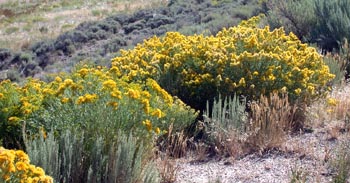Birchleaf Mountain Mahogany

Common Name(s):
Rubber Rabbitbrush
Gray Rabbitbrush
Scientific Name:
Ericameria nauseosa (Pallas ex Pursh) Nesom & Baird
Scientific Name Synonyms:
Chrysothamnus nauseosus (Pall.) Britt.
Symbol:
ERNA10
Description:
Life Span: Perennial
Origin: Native
Season: Short day
Growth Characteristics: A 12 to 90 inch tall shrub with a rounded crown and several erect stems from the base. It flowers June to September, and reproduces from seeds and root sprouts. The inflorescences and bracts of the seeds often persist well into the next year.
Flowers/Inflorescence: Yellowish green flower, ½ inch long or smaller, arranged in an umbrella shaped head.
Fruits/Seeds: Fruit is an achene.
Leaves: Alternate, linear to spatula shaped blades with entire margins. The leaves are 1 to 3 nerved.
Stems: Twigs are erect, flexible (rubbery), yellowish-green, and covered with a dense felt-like covering. The trunk is gray-brown with small cracks. The bark is fibrous and somewhat shreddy.
Ecological Adaptions:
Rubber rabbitbrush occurs in the cold deserts of the Colorado Plateau, throughout much of the Great Basin, and in warm deserts of the Southwest from lower-elevation Sonoran to subalpine zones. Rubber rabbitbrush favors sunny, open sites throughout a wide variety of habitats including open plains, valleys, drainage ways, foothills, and mountains. It is particularly common on disturbed sites. Rubber rabbitbrush is cold hardy, and tolerant of both moisture and salt stress.
Rubber rabbitbrush exhibits a number of adaptations for surviving in an arid environment. One of these is that leaves and stems are covered with a felt-like layer of trichomes that insulate the plant and reduce transpiration.
Soils: Rubber rabbitbrush grows on a wide range of soils. Soils tend to be medium to coarse-textured and somewhat basic, but may range from moderately acidic to strongly alkaline. This shrub commonly grows on dry, sandy, gravelly or heavy clay, and is somewhat salt tolerant.
Associated Species: Chokecherry, basin wildrye, big sagebrush, western wheatgrass.
Uses and Management:
Rubber rabbitbrush is, in general, considered of little value to all classes of livestock. It is an important browse species on depleted rangelands. In general, wildlife and livestock forage only lightly on this species during the summer, but winter use can be heavy in some locations. Fall use is variable, but flowers are often used by wildlife and livestock. A few leaves and the more tender stems may also be used. It is occasionally reported to be toxic to livestock.
Dense stands of rubber rabbitbrush may indicate poor range management or abandoned agricultural land.
American Indians made chewing gum from pulverized wood and bark. It was also used as tea, cough syrup, yellow dye, and for chest pains. It is a small commercial source for rubber extraction, and was studied extensively during World War II as a substitute for commercial rubber.

